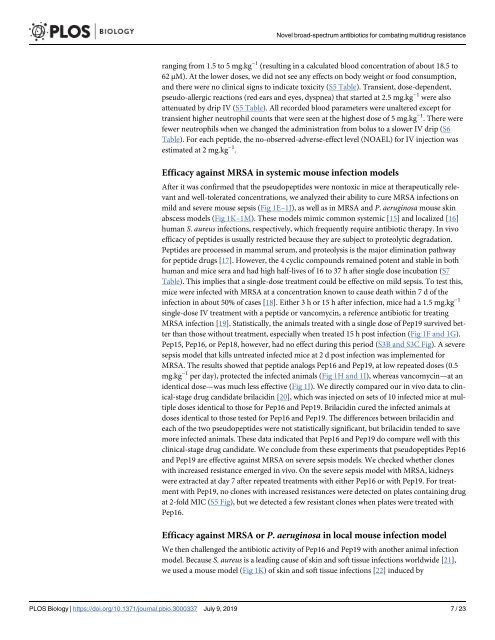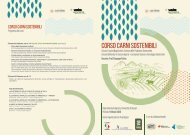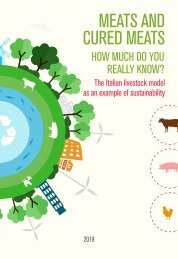Novel antibiotics effective against grampositive and -negative multi-resistant bacteria with limited resistance
Antibiotics are a medical wonder, but an increasing frequency of resistance among most human pathogens is rendering them ineffective. If this trend continues, the consequences for public health and for the general community could be catastrophic. The current clinical pipeline, however, is very limited and is dominated by derivatives of established classes, the “me too” compounds.
Antibiotics are a medical wonder, but an increasing frequency of resistance among most human pathogens is rendering them ineffective. If this trend continues, the consequences for public health and for the general community could be catastrophic. The current clinical pipeline, however, is very limited and is dominated by derivatives of established classes, the “me too” compounds.
Create successful ePaper yourself
Turn your PDF publications into a flip-book with our unique Google optimized e-Paper software.
<strong>Novel</strong> broad-spectrum <strong>antibiotics</strong> for combating <strong>multi</strong>drug <strong>resistance</strong><br />
ranging from 1.5 to 5 mg.kg −1 (resulting in a calculated blood concentration of about 18.5 to<br />
62μM). At the lower doses, we did not see any effects on body weight or food consumption,<br />
<strong>and</strong> there were no clinical signs to indicate toxicity (S5 Table). Transient, dose-dependent,<br />
pseudo-allergic reactions (red ears <strong>and</strong> eyes, dyspnea) that started at 2.5 mg.kg −1 were also<br />
attenuated by drip IV (S5 Table). All recorded blood parameters were unaltered except for<br />
transient higher neutrophil counts that were seen at the highest dose of 5 mg.kg −1 . There were<br />
fewer neutrophils when we changed the administration from bolus to a slower IV drip (S6<br />
Table). For each peptide, the no-observed-adverse-effect level (NOAEL) for IV injection was<br />
estimated at 2 mg.kg −1 .<br />
Efficacy <strong>against</strong> MRSA in systemic mouse infection models<br />
After it was confirmed that the pseudopeptides were nontoxic in mice at therapeutically relevant<br />
<strong>and</strong> well-tolerated concentrations, we analyzed their ability to cure MRSA infections on<br />
mild <strong>and</strong> severe mouse sepsis (Fig 1E–1J), as well as in MRSA <strong>and</strong>P.aeruginosa mouse skin<br />
abscess models (Fig 1K–1M). These models mimic common systemic [15] <strong>and</strong> localized [16]<br />
humanS.aureus infections, respectively, which frequently require antibiotic therapy. In vivo<br />
efficacy of peptides is usually restricted because they are subject to proteolytic degradation.<br />
Peptides are processed in mammal serum, <strong>and</strong> proteolysis is the major elimination pathway<br />
for peptide drugs [17]. However, the 4 cyclic compounds remained potent <strong>and</strong> stable in both<br />
human <strong>and</strong> mice sera <strong>and</strong> had high half-lives of 16 to 37 h after single dose incubation (S7<br />
Table). This implies that a single-dose treatment could be <strong>effective</strong> on mild sepsis. To test this,<br />
mice were infected <strong>with</strong> MRSA at a concentration known to cause death <strong>with</strong>in 7 d of the<br />
infection in about 50% of cases [18]. Either 3 h or 15 h after infection, mice had a 1.5 mg.kg −1<br />
single-dose IV treatment <strong>with</strong> a peptide or vancomycin, a reference antibiotic for treating<br />
MRSA infection [19]. Statistically, the animals treated <strong>with</strong> a single dose of Pep19 survived better<br />
than those <strong>with</strong>out treatment, especially when treated 15 h post infection (Fig 1F <strong>and</strong> 1G).<br />
Pep15, Pep16, or Pep18, however, had no effect during this period (S3B <strong>and</strong> S3C Fig). A severe<br />
sepsis model that kills untreated infected mice at 2 d post infection was implemented for<br />
MRSA. The results showed that peptide analogs Pep16 <strong>and</strong> Pep19, at low repeated doses (0.5<br />
mg.kg −1 per day), protected the infected animals (Fig 1H <strong>and</strong> 1I), whereas vancomycin—at an<br />
identical dose—was much less <strong>effective</strong> (Fig 1J). We directly compared our in vivo data to clinical-stage<br />
drug c<strong>and</strong>idate brilacidin [20], which was injected on sets of 10 infected mice at <strong>multi</strong>ple<br />
doses identical to those for Pep16 <strong>and</strong> Pep19. Brilacidin cured the infected animals at<br />
doses identical to those tested for Pep16 <strong>and</strong> Pep19. The differences between brilacidin <strong>and</strong><br />
each of the two pseudopeptides were not statistically significant, but brilacidin tended to save<br />
more infected animals. These data indicated that Pep16 <strong>and</strong> Pep19 do compare well <strong>with</strong> this<br />
clinical-stage drug c<strong>and</strong>idate. We conclude from these experiments that pseudopeptides Pep16<br />
<strong>and</strong> Pep19 are <strong>effective</strong> <strong>against</strong> MRSA on severe sepsis models. We checked whether clones<br />
<strong>with</strong> increased <strong>resistance</strong> emerged in vivo. On the severe sepsis model <strong>with</strong> MRSA, kidneys<br />
were extracted at day 7 after repeated treatments <strong>with</strong> either Pep16 or <strong>with</strong> Pep19. For treatment<br />
<strong>with</strong> Pep19, no clones <strong>with</strong> increased <strong>resistance</strong>s were detected on plates containing drug<br />
at 2-fold MIC (S5 Fig), but we detected a few <strong>resistant</strong> clones when plates were treated <strong>with</strong><br />
Pep16.<br />
Efficacy <strong>against</strong> MRSA orP.aeruginosa in local mouse infection model<br />
We then challenged the antibiotic activity of Pep16 <strong>and</strong> Pep19 <strong>with</strong> another animal infection<br />
model. BecauseS.aureus is a leading cause of skin <strong>and</strong> soft tissue infections worldwide [21],<br />
we used a mouse model (Fig 1K) of skin <strong>and</strong> soft tissue infections [22] induced by<br />
PLOS Biology | https://doi.org/10.1371/journal.pbio.3000337 July 9, 2019 7 / 23


















